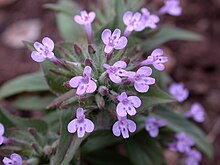Ziziphora capitata
Appearance
| Ziziphora capitata | |
|---|---|

| |
| Ziziphopra capitata in Mount Carmel, Israel | |
| Scientific classification | |
| Kingdom: | Plantae |
| Clade: | Tracheophytes |
| Clade: | Angiosperms |
| Clade: | Eudicots |
| Clade: | Asterids |
| Order: | Lamiales |
| Family: | Lamiaceae |
| Genus: | Ziziphora |
| Species: | Z. capitata
|
| Binomial name | |
| Ziziphora capitata | |
Ziziphora capitata is an annual herb in the family Lamiaceae. It grows from the Mediterranean basin to Iran including the Sinai, Palestine / Israel, Lebanon, Syria, Turkey, Cyprus, Balkans, southern Russia, Caucasus, and northern Iraq.[2][3]
Description
Ziziphora capitata grows from 3 to 12 cm high with simple or branched stems. The aromatic leaves are covered with fine hairs. The lower leaves are from 1 to 2.5 cm long and 0.5 to 0.8 cm wide, linear-lanceolate to elliptic blades and the upper floral leaves are rhombic-ovate. The flowers are tubular, with violet, purple or pink corolla. Flowers are arranged in a globose terminal head, subtended by rhombic-ovate bracts.[1][3]
Subspecies and varieties
- Ziziphora capitata var. capitata
- Ziziphora capitata var. alba
- Ziziphora capitata subsp. orientalis[2]
References
- ^ a b "Ziziphora capitata L., Sp. Pl.: 21 (1753)". Royal Botanic Gardens, Kew. Retrieved 8 May 2014.
- ^ a b c Bou Dagher-Kharrat M, et al. (2013). "Ziziphora capitata L." Species. Lebanon flora. Retrieved 8 May 2014.
- ^ a b "Ziziphora capitata L." Lifedesk. Retrieved 8 May 2014.
Further reading
- Walter Erhardt, Erich Götz, Nils Bödeker, Siegmund Seybold: Der große Zander. Eugen Ulmer KG, Stuttgart 2008, ISBN 978-3-8001-5406-7. (Ger.)
- Christoper Brickell (Editor-in-chief): RHS A-Z Encyclopedia of Garden Plants. Third edition. Dorling Kindersley, London 2003, ISBN 0-7513-3738-2.
